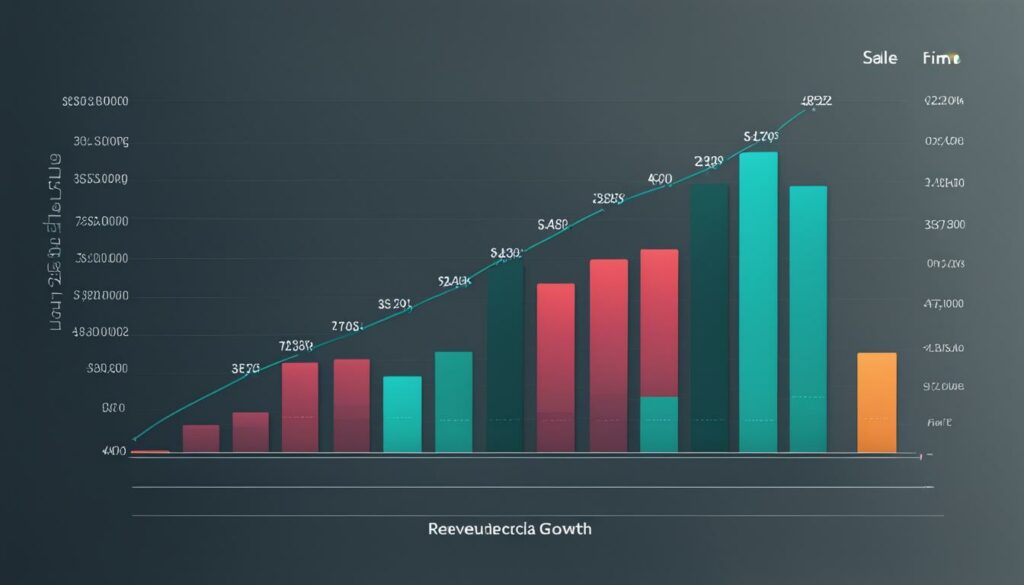Greetings! In this article, I will discuss the concept of revenue in ecommerce and its significance for online businesses. Revenue in ecommerce refers to the income generated through the sale of products or services in an online business. It encompasses the total amount of money earned from customer purchases, including both one-time sales and recurring subscriptions.
Ecommerce revenue is crucial for the growth and profitability of online businesses. It serves as a key performance metric and provides insight into the financial health of an ecommerce operation. By understanding how to optimize, manage, and forecast revenue, businesses can make informed decisions and drive success in the digital marketplace.
Key Takeaways:
- Revenue in ecommerce refers to the income generated through the sale of products or services in an online business.
- Ecommerce revenue is crucial for the growth and profitability of online businesses.
- Understanding how to optimize, manage, and forecast revenue is essential for success in the digital marketplace.
Ecommerce Revenue: Definition and Importance
Ecommerce revenue, also known as online sales revenue, refers to the total amount of money earned from the sale of products or services in an online business. It is a crucial metric for measuring the financial performance and success of an ecommerce operation. By analyzing and optimizing revenue streams, businesses can identify opportunities for growth and improve the overall performance of their online stores.
Ecommerce revenue generation is of paramount importance for sustaining the business, covering expenses, and driving growth. Without a steady stream of revenue, an ecommerce business would struggle to operate and expand. It is the lifeblood of the online business, enabling investment in marketing, technology, inventory, and customer experience enhancements.
Optimizing ecommerce revenue involves understanding customer behavior, implementing effective marketing strategies, enhancing the shopping experience, and maximizing the conversion rate. This requires analyzing data, identifying trends, and proactively adjusting business strategies to align with changing market demands and customer expectations.
By focusing on revenue generation in ecommerce, businesses can achieve the following:
- Increase profitability: Higher revenue means greater profit potential. By optimizing revenue generation, businesses can maximize their bottom line and create a sustainable financial foundation for growth and expansion.
- Enhance customer experience: Revenue generation is closely tied to customer satisfaction. By prioritizing the customer experience, businesses can attract and retain loyal customers, leading to repeat purchases and increased revenue.
- Drive business growth: Ecommerce revenue fuels business growth by providing the necessary resources to invest in marketing, technology, and infrastructure. It enables businesses to reach new customers, expand product offerings, and enter new markets.
- Stay competitive: In today’s digital landscape, where competition is fierce, businesses need to continually innovate and adapt. By generating revenue, businesses can stay competitive by investing in research and development, staying ahead of industry trends, and delivering unique value propositions.
Overall, ecommerce revenue is a critical metric that determines the financial health and prosperity of an online business. By focusing on revenue generation and implementing effective strategies to optimize sales, ecommerce businesses can position themselves for long-term success in the digital marketplace.
Strategies to Increase Ecommerce Revenue
| Strategy | Description |
|---|---|
| Improving website design and user experience | Enhancing the visual appeal, navigation, and overall usability of the website to create a seamless and enjoyable shopping experience for customers. |
| Implementing targeted marketing campaigns | Creating personalized and relevant marketing campaigns to attract and engage specific customer segments, maximizing the chances of conversion. |
| Offering personalized recommendations | Utilizing customer data and artificial intelligence algorithms to provide tailored product recommendations based on individual preferences and browsing history. |
| Cross-selling and upselling | Promoting related products or more expensive alternatives to increase the average order value and maximize revenue per customer. |
| Optimizing product pricing and discounts | Analyzing market trends and competitor pricing to set competitive prices and strategically offer discounts that motivate customers to make a purchase. |
| Leveraging social media and influencer marketing | Using social media platforms and collaborating with influencers to reach a wider audience, increase brand awareness, and drive sales. |

Calculating Revenue in Ecommerce
When it comes to measuring the financial success of an ecommerce business, calculating revenue is a vital step. By determining the total amount of money earned from customer purchases, businesses can gain valuable insights into their financial performance and make data-driven decisions to drive growth. In this section, we will explore the various methods and formulas used to calculate revenue in ecommerce.
Revenue Calculation Methods
There are different methods available for calculating ecommerce revenue, depending on the nature of the business and the revenue streams involved. The most common method is to multiply the number of units sold by the price per unit. This formula provides a straightforward calculation, giving businesses a clear understanding of their revenue.
However, it’s important to note that additional factors such as discounts, returns, and refunds may need to be considered in the revenue calculation process. These factors can have a significant impact on the final revenue figure and should be accurately accounted for to ensure an accurate representation of the business’s financial performance.
Ecommerce Revenue Formula
To calculate revenue in ecommerce, the following formula is typically used:
Total Revenue = Number of Units Sold x Price per Unit
Let’s consider an example to illustrate this formula. Suppose an ecommerce business sells 100 units of a product at a price of $20 per unit. Using the formula, we can calculate the revenue as follows:
Total Revenue = 100 units x $20 per unit = $2,000
By utilizing this formula, ecommerce businesses can accurately calculate their revenue and gain valuable insights into their financial performance. This information can then be used to optimize pricing strategies, evaluate the effectiveness of marketing campaigns, and make informed decisions to drive revenue growth.

| Revenue Calculation Method | Formula |
|---|---|
| Multiplying number of units sold by price per unit | Total Revenue = Number of Units Sold x Price per Unit |
Strategies to Increase Ecommerce Revenue
Increasing ecommerce revenue requires implementing effective strategies to optimize sales and drive growth. By employing the right revenue optimization strategies, ecommerce businesses can attract more customers, increase average order value, and ultimately generate higher revenue.
1. Improve Website Design and User Experience
A well-designed website that offers a seamless user experience is crucial for driving ecommerce revenue. Enhance your website’s loading speed, optimize its layout and navigation, and ensure it is mobile-friendly. Employ a visually appealing design that reflects your brand identity and makes it easy for customers to find products and complete their purchases.
2. Implement Targeted Marketing Campaigns
Segment your audience based on demographics, purchase history, and browsing behavior, and create personalized marketing campaigns. Utilize email marketing, social media advertising, and pay-per-click (PPC) campaigns to reach your target audience with tailored promotions and offers. By targeting the right customers with the right messaging, you can increase conversion rates and revenue.
3. Offer Personalized Recommendations
Use customer data and browsing history to provide personalized product recommendations. Implement recommendation engines that suggest relevant products based on the customer’s preferences and previous purchases. Personalized recommendations can lead to higher customer engagement, increased average order value, and repeat purchases.
4. Cross-Selling and Upselling
Encourage customers to add more items to their cart through cross-selling and upselling techniques. Cross-selling involves recommending complementary products, while upselling involves suggesting higher-priced alternatives. Both strategies can significantly increase the average order value and contribute to revenue growth.
5. Optimize Product Pricing and Discounts
Regularly analyze and adjust your product pricing strategy to find the optimal balance between competitiveness and profitability. Offer discounts and promotions strategically, whether it’s percentage-based discounts, buy-one-get-one-free offers, or limited-time deals. Effective pricing and discount optimization can drive higher sales volumes and revenue.
6. Leverage Social Media and Influencer Marketing
Utilize social media platforms to promote your products and engage with customers. Run targeted advertising campaigns, collaborate with influencers, and encourage user-generated content to boost brand awareness and attract new customers. Social media marketing can help drive traffic to your ecommerce store and increase revenue.

Incorporating these revenue optimization strategies into your ecommerce business can lead to significant revenue growth. By improving website design and user experience, implementing targeted marketing campaigns, offering personalized recommendations, cross-selling and upselling, optimizing product pricing and discounts, and leveraging social media and influencer marketing, you can maximize your ecommerce revenue and achieve long-term success in the digital marketplace.
Understanding Customer Behavior and Its Impact on Revenue
Customer behavior is a crucial factor in driving ecommerce revenue. By analyzing customer data and behavior patterns, businesses can gain valuable insights into their preferences, purchasing habits, and motivations. This information can be used to customize marketing strategies, personalize product recommendations, and enhance the overall customer experience. By understanding customer behavior, businesses can make data-driven decisions that lead to higher conversion rates, increased customer satisfaction, and ultimately, greater revenue.
Importance of Customer Behavior Analysis
Analyzing customer behavior in ecommerce is essential for optimizing revenue. By delving deep into customer data, businesses can uncover valuable insights that help them understand what drives their customers to make a purchase. These insights can guide businesses in tailoring their marketing campaigns, optimizing their product offerings, and creating a seamless and personalized shopping experience.
Some of the key areas where customer behavior analysis can have a significant impact on revenue are:
- Identifying customer preferences: By understanding customer preferences, businesses can curate their product offerings and marketing strategies to align with what customers want, thereby increasing the likelihood of a purchase.
- Enhancing the customer journey: Analyzing customer behavior allows businesses to identify pain points in the customer journey and make improvements that result in increased customer satisfaction and higher conversion rates.
- Optimizing pricing strategies: By understanding how customers respond to different pricing strategies, businesses can optimize their pricing models to maximize revenue and profitability.
- Personalizing the shopping experience: Customer behavior analysis enables businesses to personalize product recommendations, offers, and promotions based on individual customer preferences and purchase history, leading to increased customer engagement and retention.
Utilizing Data-Driven Insights
To effectively leverage customer behavior analysis, businesses need to collect and analyze relevant data. This includes data related to customer interactions with the website, purchase history, demographic information, and browsing behavior. By utilizing advanced analytics tools and techniques, businesses can gain actionable insights that shape their marketing strategies and drive revenue growth.
“Analyzing customer behavior allows ecommerce businesses to make data-driven decisions that lead to increased conversion rates, customer satisfaction, and ultimately, higher revenue.”
Key Metrics for Customer Behavior Analysis
To analyze customer behavior and its impact on revenue, businesses can track and monitor key metrics. Some of the most important metrics include:
- Conversion rate: Measures the percentage of website visitors who make a purchase, providing insights into the effectiveness of marketing campaigns and the overall customer experience.
- Customer lifetime value: Estimates the total revenue a customer is expected to generate during their relationship with the business, helping prioritize customer acquisition and retention efforts.
- Cart abandonment rate: Measures the percentage of customers who add products to their cart but fail to complete the purchase, highlighting potential friction points in the buying process.
- Repeat purchase rate: Calculates the percentage of customers who make multiple purchases, indicating customer loyalty and the effectiveness of retention initiatives.
By regularly monitoring these metrics and conducting in-depth customer behavior analysis, businesses can make informed decisions that drive revenue growth and enhance the overall customer experience.

Understanding customer behavior and its impact on revenue is essential for ecommerce businesses looking to thrive in a highly competitive market. By analyzing customer data, businesses can gain valuable insights, tailor their strategies, and create a personalized shopping experience that leads to increased conversions, customer satisfaction, and ultimately, higher revenue.
The Relationship Between Revenue and Other Metrics in Ecommerce
When it comes to ecommerce, revenue is just one piece of the puzzle. There are several other metrics that businesses need to consider in order to gain a comprehensive understanding of their performance and make informed decisions. The relationship between revenue and these other metrics provides valuable insights and opportunities for optimization in ecommerce revenue management.
One of the key metrics closely tied to revenue is the conversion rate. The conversion rate measures the percentage of website visitors who make a purchase. Analyzing this metric alongside revenue allows businesses to gauge the effectiveness of their sales funnel and identify potential areas for improvement. A higher conversion rate indicates that the website is successfully converting visitors into paying customers, leading to increased revenue.
“A higher conversion rate indicates that the website is successfully converting visitors into paying customers, leading to increased revenue.”
Another metric that directly impacts revenue is the average order value (AOV). The AOV measures the average amount spent by customers in a single transaction. By increasing the AOV, businesses can generate more revenue from each customer. This can be achieved through cross-selling and upselling strategies, as well as offering discounts for larger purchases. Analyzing the relationship between AOV and revenue helps businesses optimize their pricing and promotions to maximize revenue.
Customer lifetime value (CLTV) is another critical metric in ecommerce revenue analysis. CLTV measures the total value a customer brings to a business over their entire relationship. By understanding the CLTV, businesses can make data-driven decisions to acquire and retain high-value customers. Increasing CLTV through strategic marketing, personalized experiences, and exceptional customer service can have a significant impact on overall revenue.
“Increasing CLTV through strategic marketing, personalized experiences, and exceptional customer service can have a significant impact on overall revenue.”
Customer retention rate is yet another metric that ecommerce businesses must consider in revenue management. It measures the percentage of customers who continue to make repeat purchases. A higher customer retention rate indicates that customers are satisfied with their experience and are more likely to generate recurring revenue. By focusing on improving customer loyalty and retention, businesses can boost revenue and reduce the need for costly customer acquisition efforts.
To effectively manage revenue in ecommerce, it is essential to take a holistic approach that considers the interplay between revenue and other performance indicators. By tracking and monitoring these metrics, businesses can uncover valuable insights, make data-driven decisions, and implement strategies to optimize revenue generation. A comprehensive understanding of the relationship between revenue and other ecommerce metrics allows businesses to identify areas for improvement and ensure long-term success in the competitive digital marketplace.
| Metric | Definition | Importance |
|---|---|---|
| Conversion Rate | The percentage of website visitors who make a purchase | Measures sales funnel effectiveness and identifies areas for improvement |
| Average Order Value (AOV) | The average amount spent by customers in a single transaction | Influences revenue by maximizing earnings from each customer |
| Customer Lifetime Value (CLTV) | The total value a customer brings to a business over their entire relationship | Optimizing CLTV leads to increased revenue and profitability |
| Customer Retention Rate | The percentage of customers who continue to make repeat purchases | Reduces the need for costly customer acquisition and boosts recurring revenue |
Challenges and Considerations in Ecommerce Revenue Management
Ecommerce revenue management poses unique challenges and requires careful considerations in order to navigate the competitive digital marketplace. Some of the common challenges faced by ecommerce businesses include:
- Increasing competition: With more businesses going online, the competition for customer attention and sales has intensified. Ecommerce businesses need to find innovative ways to stand out and attract customers.
- Rising customer acquisition costs: As the digital landscape becomes more crowded, customer acquisition costs have also risen. Ecommerce businesses must evaluate their marketing strategies to ensure maximum return on investment.
- Managing inventory and fulfillment: Efficiently managing inventory and fulfillment can be a complex task for ecommerce businesses. Ensuring that products are available and delivered in a timely manner is crucial for customer satisfaction.
- Dealing with returns and refunds: Ecommerce businesses need to have robust systems in place to handle returns and refunds. This includes managing customer expectations, streamlining the return process, and minimizing the impact on revenue.
- Keeping up with changing consumer preferences and technology: Consumer preferences and technology evolve rapidly in the ecommerce industry. Businesses must stay updated on the latest trends and adapt their strategies accordingly to stay relevant.
In addition to these challenges, accurate revenue forecasting is essential for effective financial planning and decision-making in ecommerce. By forecasting revenue, businesses can better allocate resources, plan for growth, and make informed strategic decisions.
Revenue Management Considerations
When it comes to revenue management in ecommerce, there are several key considerations that businesses need to keep in mind:
- Market trends: Staying informed about market trends is crucial for understanding consumer behavior and making data-driven revenue management decisions.
- Performance metrics: Tracking and analyzing performance metrics such as conversion rates, average order value, and customer lifetime value provides valuable insights into the effectiveness of revenue management strategies.
- Adaptability: Ecommerce businesses need to be adaptable and flexible in their revenue management strategies. This includes regularly evaluating and adjusting pricing strategies, promotional campaigns, and customer engagement techniques.
By taking these considerations into account, ecommerce businesses can effectively manage their revenue, overcome challenges, and stay competitive in the dynamic online marketplace.
| Challenge | Considerations |
|---|---|
| Increasing competition | Evaluate unique selling points, invest in digital marketing, differentiate brand identity |
| Rising customer acquisition costs | Target specific audience segments, optimize ad campaigns, explore partnerships |
| Managing inventory and fulfillment | Implement efficient inventory management systems, streamline fulfillment processes |
| Dealing with returns and refunds | Establish clear return policies, automate refund processes, focus on customer satisfaction |
| Keeping up with changing consumer preferences and technology | Monitor industry trends, conduct market research, leverage data analytics |
Conclusion: Optimizing Revenue in Ecommerce
Maximizing revenue in ecommerce requires a comprehensive approach that combines data analysis, strategic implementation, and consistent monitoring of market trends. By focusing on revenue optimization, ecommerce businesses can drive growth, increase profitability, and achieve long-term success in the digital marketplace.
One effective strategy for optimizing ecommerce revenue is to enhance the customer experience. By improving website design, navigation, and checkout processes, businesses can create a seamless and enjoyable shopping journey, increasing the likelihood of conversions and repeat purchases. Personalization is also key, as tailored product recommendations and personalized marketing messages can significantly boost customer engagement and revenue.
Another revenue optimization tactic is targeted marketing. By leveraging data-driven insights and analytics, businesses can identify and target their ideal customers with precision. This allows for the implementation of targeted marketing campaigns that focus on reaching the right audience at the right time, leading to higher conversion rates and increased revenue.
Furthermore, ecommerce businesses should leverage data analytics and metrics to gain insights into customer behavior and preferences. By understanding customer needs and motivations, businesses can optimize their product offerings, pricing strategies, and promotional activities to align with customer expectations, resulting in higher sales and revenue growth.
In conclusion, optimizing ecommerce revenue is a multifaceted process that requires a strategic and data-driven approach. By implementing customer-centric strategies, leveraging targeted marketing, and continuously analyzing and adapting to market trends, ecommerce businesses can maximize revenue, achieve sustainable growth, and thrive in the competitive digital marketplace.
FAQ
What is revenue in ecommerce?
Revenue in ecommerce refers to the income generated through the sale of products or services in an online business. It encompasses the total amount of money earned from customer purchases, including both one-time sales and recurring subscriptions.
Why is ecommerce revenue important?
Ecommerce revenue is crucial for the growth and profitability of online businesses. Revenue generation in ecommerce is essential for sustaining the business, covering expenses, and driving growth.
How do you calculate revenue in ecommerce?
Calculating revenue in ecommerce involves determining the total amount of money earned from customer purchases. The most common formula is to multiply the number of units sold by the price per unit, but other factors such as discounts, returns, and refunds may need to be considered as well.
What are some strategies to increase ecommerce revenue?
Key strategies to increase ecommerce revenue include improving website design and user experience, implementing targeted marketing campaigns, offering personalized recommendations, optimizing pricing and discounts, and leveraging social media and influencer marketing.
How does customer behavior impact ecommerce revenue?
Customer behavior plays a significant role in driving ecommerce revenue. By analyzing customer data and behavior patterns, online businesses can gain insights into customer preferences, purchasing habits, and motivations, allowing them to tailor strategies and optimize the overall customer experience.
What is the relationship between revenue and other metrics in ecommerce?
Revenue in ecommerce is closely related to other metrics such as conversion rate, average order value, customer lifetime value, and customer retention rate. Analyzing the relationship between these metrics provides insights into the overall performance of an ecommerce business and helps identify areas for improvement.
What are the challenges in ecommerce revenue management?
Common challenges in ecommerce revenue management include increasing competition in the digital marketplace, rising customer acquisition costs, managing inventory and fulfillment, dealing with returns and refunds, and keeping up with changing consumer preferences and technology.
How can ecommerce revenue be optimized?
Optimizing revenue in ecommerce involves analyzing data, implementing effective strategies, and continuously monitoring market trends. Strategies such as improving customer experience, personalization, targeted marketing, and leveraging data-driven insights can help maximize revenue and drive sustained growth.
